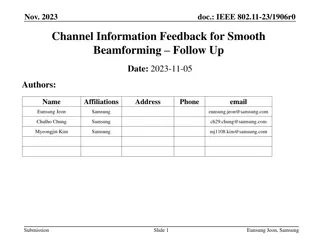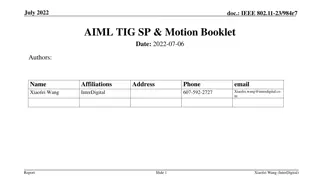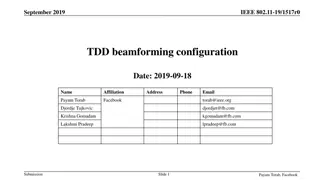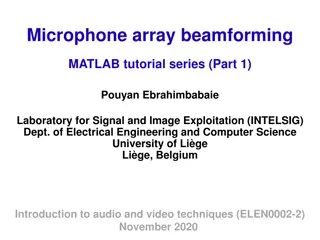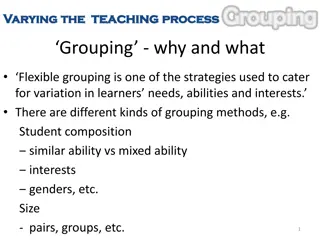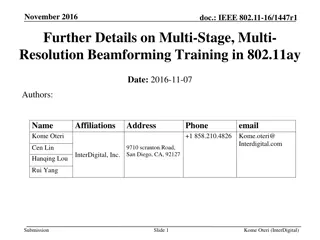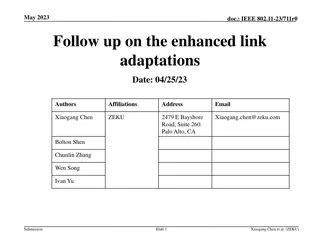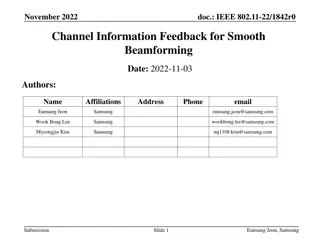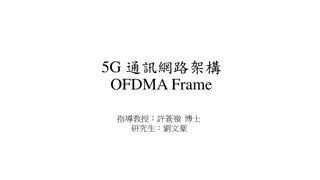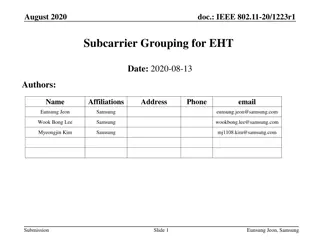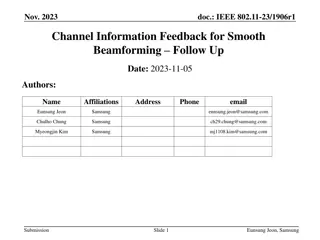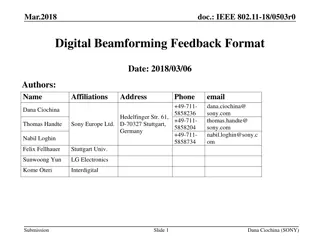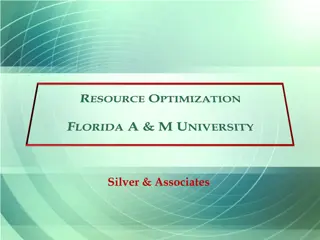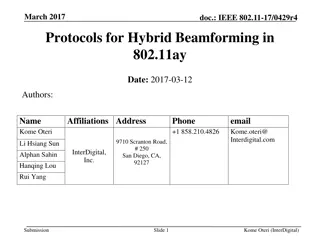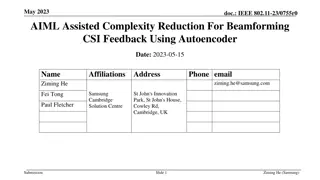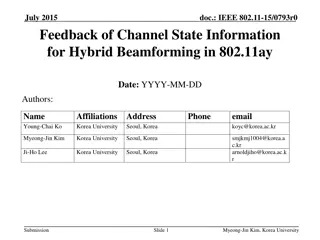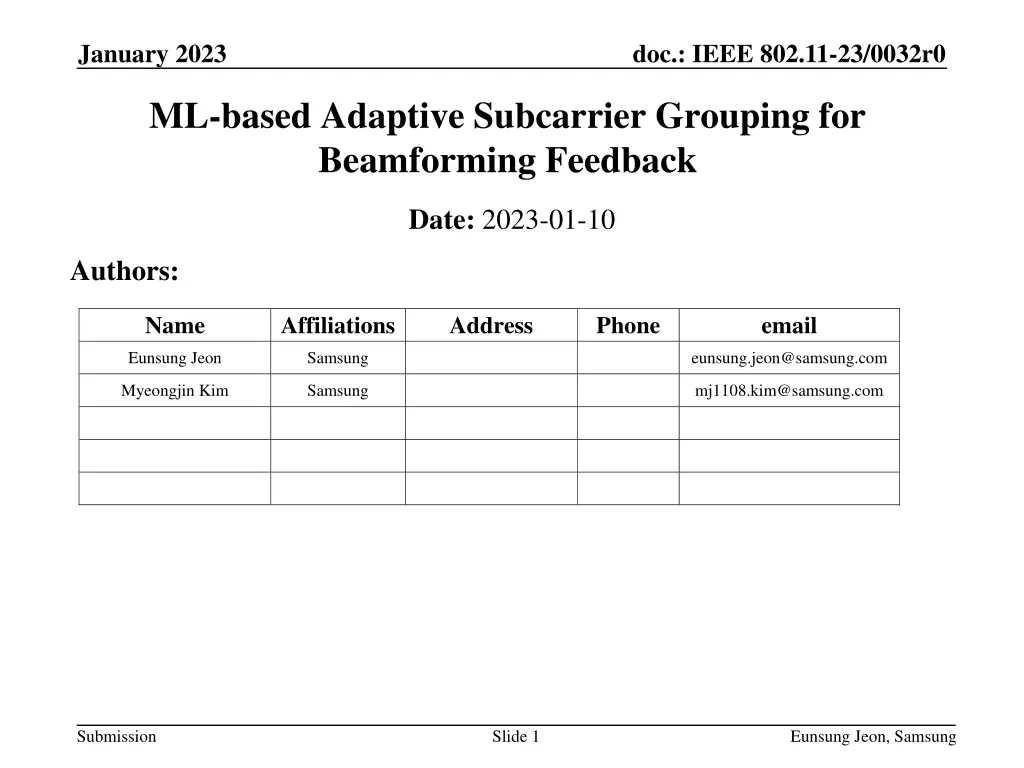
Adaptive Subcarrier Grouping for Beamforming Feedback
Explore the ML-based approach for adaptive subcarrier grouping in beamforming feedback to enhance efficiency and reduce overhead in transmitting channel state information. The study delves into determining the subcarrier grouping value according to real-time channel conditions, aiming to optimize beamforming procedures.
Download Presentation

Please find below an Image/Link to download the presentation.
The content on the website is provided AS IS for your information and personal use only. It may not be sold, licensed, or shared on other websites without obtaining consent from the author. If you encounter any issues during the download, it is possible that the publisher has removed the file from their server.
You are allowed to download the files provided on this website for personal or commercial use, subject to the condition that they are used lawfully. All files are the property of their respective owners.
The content on the website is provided AS IS for your information and personal use only. It may not be sold, licensed, or shared on other websites without obtaining consent from the author.
E N D
Presentation Transcript
January 2023 doc.: IEEE 802.11-23/0032r0 ML-based Adaptive Subcarrier Grouping for Beamforming Feedback Date: 2023-01-10 Authors: Name Affiliations Address Phone email Eunsung Jeon Samsung eunsung.jeon@samsung.com Myeongjin Kim Samsung mj1108.kim@samsung.com Submission Slide 1 Eunsung Jeon, Samsung
January 2023 doc.: IEEE 802.11-23/0032r0 Recap: Beamforming procedure For transmit beamforming, BFer requires the channel state information (CSI), which is delivered from the BFee. BFer sends an NDP for sounding purpose. BFee feeds back CSI. Estimated channel matrix H is decomposed to U?Vh via SVD and V is chosen as a beamforming feedback matrix (BFM). The BFM is compressed in form of angles (?,?) by using the Givens rotation. The codebook size (i.e., number of bits for quantization to the angles) and subcarrier grouping size are determined by BFee. BFer reconstructs V and applies it for the beam-steering matrix. Submission Slide 2 Eunsung Jeon, Samsung
January 2023 doc.: IEEE 802.11-23/0032r0 Recap: Subcarrier grouping Subcarrier grouping Assuming that the channel frequency response is correlated across the subcarriers, only a single BFM is fed back for each group of Ng adjacent subcarriers. Some sort of interpolation needs to be performed by BFer to obtain the beam- steering matrix for rest of the subcarriers. By using the grouping, the overhead for CSI feedback can be reduced. If Ng value is large, CSI becomes inaccurate. If Ng value is small, CSI overhead becomes large. Subcarriers for which BFM is send back Ng value of subcarrier grouping 11ac 1, 2, 4 11ax, 11be 4, 16 Ng=4 Frequency Submission Slide 3 Eunsung Jeon, Samsung
January 2023 doc.: IEEE 802.11-23/0032r0 Motivation To the best of our knowledge, there is no study on how to determine the subcarrier grouping value adaptively according to real-time channel conditions. Basic idea Highly frequency selective channel BFee selects a small Ng value (e.g. Ng = 4 ) Small frequency selective channel BFee selects a large Ng value (e.g. Ng = 16 ) Submission Slide 4 Eunsung Jeon, Samsung
January 2023 doc.: IEEE 802.11-23/0032r0 Measurement of channel frequency selectivity As a measurement of the channel frequency selectivity, the following features can be considered in the frequency and time domain respectively. Variance of CFR (channel frequency response) The variance channel frequency response is calculated as 2 2 1 ?? 1 1 1 ? ?=0 ?? 1 ?=0 ? 1 ??(?,?) ? 1 ??(?,?) 2= ???? ?=0 ? ?=0 ?? ??(?,?) is the estimated channel for the k-th subcarrier for the ij-th element Delay spread of CIR (channel impulse response) The mean channel delay spread is calculated as 1 ?? 1???? ? ?,? ?? 1 ?=0 ???? ?=0 ?????= where ? ?,? = ? ?? (?,?) ??+ (?,?) , IDFT( ) is the inverse DFT function Submission Slide 5 Eunsung Jeon, Samsung
January 2023 doc.: IEEE 802.11-23/0032r0 Distribution of CFR variance The IEEE channel model is classified into A, B, C, D, and E in the order of high frequency selectivity. Distribution of CFR variance We observe that the distribution can be distinguished according to the channel models in the middle (or high) SNR. SNR = 15dB SNR = 0dB SNR = 10dB Submission Slide 6 Eunsung Jeon, Samsung
January 2023 doc.: IEEE 802.11-23/0032r0 Threshold-based channel classification As a simple method, a threshold-based classification can be used that determines the threshold in a heuristic way [1]. Given SNR estimates, Ng is determined based on a threshold which is set differently according to the SNR. Only binary-level classification is possible. Example If SNR > SNR_1 & SNR SNR_2 and Variance (?? Then Ng = 16. 2) < TH_2, SNR SNR_1 Th_1 SNR_2 Th_2 SNR_K Th_K Threshold Submission Slide 7 Eunsung Jeon, Samsung
January 2023 doc.: IEEE 802.11-23/0032r0 ML-based channel classification To order to improve performance, ML can be used to classify the channels. Multi-level classification is possible. Supervised learning Generate random channels for each class. Configure a set of data samples to be used to train the machine. Data sample = (SNR, Variance, Delay spread) For a new incoming sample, its class is assigned by the trained machine, and Ng is determined based on the assigned class. Variance Class I / Class II Delay Spread or Class I / Class II / Class III SNR Submission Slide 8 Eunsung Jeon, Samsung
January 2023 doc.: IEEE 802.11-23/0032r0 Example of channel classification Binary-level classification Ng Class Feature IEEE channel Model Frequency flat channel Class I A Ng = 16 Frequency selective channel Class II B, C, D, E, F Ng = 4 Multi-level classification Ng Class Feature IEEE channel Model Frequency flat channel Class I A Ng = NST Low frequency selective channel Class II B, C Ng = 16 High frequency selective channel Class III D, E, F Ng = 4 Submission Slide 9 Eunsung Jeon, Samsung
January 2023 doc.: IEEE 802.11-23/0032r0 Ng = NST for frequency flat channel Ng = NST NST : Total number of subcarriers in a non-punctured non-OFDMA PPDU BW20 BW40 BW80 BW160 BW320 242 484 996 1992 3984 NST Only a single BFM is fed back for NST subcarriers. The BFM for the remaining subcarriers can be obtained by copying and pasting the single BFM. The overhead for CSI feedback can be significantly reduced. Subcarrier for which the BFM is sent back ... Ng=NST Frequency Submission Slide 10 Eunsung Jeon, Samsung
January 2023 doc.: IEEE 802.11-23/0032r0 Remarks: Unsupervised learning The subcarrier grouping value (and/or the codebook size) can be determined adaptively by using an unsupervised learning algorithm. The K-means algorithm divides the given data samples into two clusters defined by centroids [4]. For the new input data sample, the algorithm determines the subcarrier grouping value based on the assigned cluster. Ng=4 Variance Ng=16 Delay Spread SNR Submission Slide 11 Eunsung Jeon, Samsung
January 2023 doc.: IEEE 802.11-23/0032r0 Simulation parameters Parameter Value PPDU type EHT Channel model A, B, C, D, E, F Learning algorithm Neural network Adaptive moment estimation (Adam) Optimization solver Number of data ~27K Number of training data 70% of data Number of testing data 30% of data Number of hidden nodes 2 Number of nodes per hidden layer [100, 100] Activation function Tanh Submission Slide 12 Eunsung Jeon, Samsung
January 2023 doc.: IEEE 802.11-23/0032r0 Simulation results (1) Classification performance Threshold-based classification The noise causes significant degradation to the performance. ML-based classification In case of binary-level classification, almost 100% success is achieved. In the case of multi-level classification, around 90% success can be achieved even in the low SNR region. Submission Slide 13 Eunsung Jeon, Samsung
January 2023 doc.: IEEE 802.11-23/0032r0 Simulation results (2) PER performance If a frequency flat channel is identified by ML, the CSI is fed back with Ng = NST . For frequency flat channel, the PER performance with Ng = NST is almost same as Ng = 4, while the CSI overhead is significantly reduced. Submission Slide 14 Eunsung Jeon, Samsung
January 2023 doc.: IEEE 802.11-23/0032r0 Conclusion In this contribution, we presented an ML-based adaptive beamforming feedback method. A supervised learning-based ML technique is used for channel classification. Based on the channel classification, the subcarrier grouping value is determined in an on-line manner. In addition, the Ng = NST option was also presented for frequency flat channel identified by ML. Significant CSI overhead reduction can be achieved without loss of PER performance. The ML-based channel classification can also be applied to adaptive codebook selection. Class Feature Codebook bits for ( , ) Class I Frequency flat channel Coarse codebook (2, 4) Class II Frequency selective channel Fine codebook (4, 6) Submission Slide 15 Eunsung Jeon, Samsung
January 2023 doc.: IEEE 802.11-23/0032r0 Reference [1] E. Jeon, Device And Method Of Performing Subcarrier Grouping And/Or Codebook Size Selection In Real-Time For Beamforming Feedback And Wireless Communication System Including The Same, US17/550172, 2021. [2] E. Kurniawan, L. Zhiwei, and S. Sun, Machine Learning-based Channel Classification and Its Application to IEEE 802.11ad Communications, in Proc. IEEE GLOBECOM, Dec. 2017. [3] H. Arslan and T. Y cek, Delay Spread Estimation for Wireless Communication Systems , in Proc. IEEE ISCC, Jul. 2003. [4] M. Deshmukh, Z. Lin, H. Lou, M. Kamel, R. Yang, and I. Guvenc, Intelligent Feedback Overhead Reduction (iFOR) in Wi-Fi 7 and Beyond, in Proc. IEEE VTC-Spring, Jun. 2022. Submission Slide 16 Eunsung Jeon, Samsung


